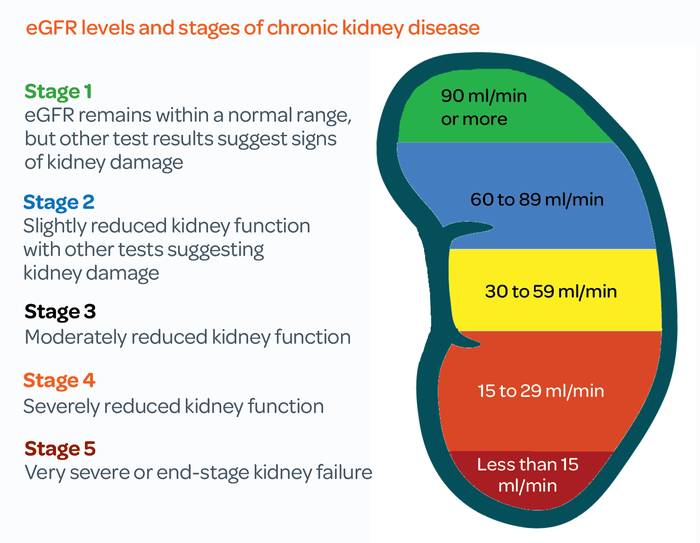Your healthcare team will use your test results to monitor your kidney function, as well as other aspects of your health. Your results can also be used to see if you’re at risk of any complications associated with CKD, such as diabetes.
Based on your test results, your healthcare team may recommend a new treatment or make changes to your existing treatment. This could include a different type or dose of medication, for example, or if you receive dialysis, a change to your dialysis schedule.
Knowing your own test results and understanding what they mean can be really empowering. It allows you to have some control over your CKD and can help you make informed decisions and positive choices for your health and wellbeing.
It is normal to feel overwhelmed and confused when you start trying to interpret your test results. It can be hard to make sense of all the medical terminology and different numbers, symbols and ranges.
This guide explains some of the things your healthcare team is looking for when they test your blood and urine, why those things are important and what the results mean.
These numbers are just a guide. It might be normal for you to have results outside of these ranges. Your clinic may also use slightly different ranges.
Sometimes the overall trend in your test results is more important than the exact numbers – for example, if a certain measurement is going up or down or remaining roughly stable. Speak to your healthcare team if you have any questions or concerns about your results.

Blood tests
Kidney function markers
There are a few key tests that check how well your kidneys are working. These tests give a snapshot of your kidney function at the time your blood is taken. Your healthcare team can also compare results over a period of months and years to track the progression of your condition.
Creatinine
Creatinine is a waste product that your muscles make during normal everyday activity. Your kidneys filter creatinine from your blood and pass it out of your body in your urine. When your kidneys don’t work very well, creatinine builds up in your blood. It’s not harmful, but the level of creatinine in your blood is a good indicator of your kidney function.
Normal range in people without CKD:
Males: 64 – 104 micromoles per litre (μmol/L)
Females: 49 – 90 micromoles per litre (μmol/L)
CKD range: Individual to each patient.
Lower is generally better.
Normal creatinine levels vary according to your age, sex, ethnicity and build. For example, people with a higher muscle mass will produce more creatinine and therefore have higher levels, but this doesn’t necessarily mean that they have CKD.
Other factors can affect creatinine levels too, like:
- whether you’ve recently exercised
- if you have other health conditions
- how much protein you have in your diet. You may be asked to avoid eating meat for 12 hours before a blood test because the cooking process turns a chemical found in meat, called creatine, into creatinine. This can increase your creatinine levels and give a misleading reading.

Urea
Urea is a waste product that is made in your liver when it breaks down protein from your diet. Your kidneys normally filter waste products out of your blood and your body gets rid of them in your urine. So, if the urea levels in your blood are high, it’s a sign that your kidneys might not be working well.
Normal range in people without CKD: 2.5 – 7.8 millimoles per litre (mmol/L)
CKD range: Individual to each patient
Lower is generally better.
Urea levels in your blood can also be raised by dehydration or by eating a lot of protein. Along with your creatinine levels, urea levels are a good indicator of your kidney function. If you are on dialysis, urea levels show how well the treatment is cleaning waste products from your blood.
GFR and eGFR
GFR stands for glomerular filtration rate. Glomeruli are the network of tiny blood vessels inside the kidneys that separate out waste products and excess fluid from your blood. GFR shows how well your kidneys filter your blood, by indicating how much blood passes through the glomeruli every minute.
Getting an accurate measurement of your GFR is difficult, so your blood test results normally give an estimated filtration rate, or eGFR. It’s calculated based on your age, sex and your creatinine blood level. Sometimes the calculation formula includes your weight and height, too. Your eGFR may be listed as a measurement of ml/min or as a percentage. So, an eGFR of 50ml/min means your kidneys are functioning at about 50%.
eGFR is also used as an indication of what stage of CKD you have.
Higher is better.

Minerals in the blood
You may need to have blood tests to check for levels of certain minerals. When your kidneys can’t filter them out of your blood, the mineral levels can change (either up or down) which can cause problems.
Sodium
Sodium comes from salt in your diet. Your muscles and nerves need sodium to work properly, and sodium also helps to regulate your blood pressure and to keep the amount of fluid in your body in check. Too much sodium can push your blood pressure up, so you might be advised to limit your salt intake.
Normal range in people with or without CKD: 135 – 145 mmol/L
Calcium (adjusted)
Calcium is essential for bone health, and most of your body’s calcium is found in your bones. It’s also needed for your muscles and heart and helps with blood clotting. Some calcium in the body is ‘bound’ to a protein called albumin, so if your albumin levels change, it can affect your calcium levels too.
This measure of calcium is adjusted according to the amount of albumin you have in your blood, which is why it’s referred to as adjusted calcium.
Normal range in people without CKD: 2.2 – 2.6 mmol/L
Range in CKD: Individual to each patient
Phosphate
Phosphate is a chemical that is crucial for bone health. It also affects how your muscles and nerves function and releases energy to the different parts of your body. Phosphate levels tend to be higher if you have kidney disease, which can cause itching and sore eyes, as well as weakened bones, and muscle and joint pain.
Normal range in people without CKD: 0.7 – 1.4 mmol/L
Range in CKD: Less than 1.8 mmol/L
There is some debate about the management of phosphate levels in people with CKD. However, if your levels go too high it can be bad for you, so it’s important that they are monitored.
Potassium
Potassium is a mineral that is normally absorbed into the blood to keep your muscles and heart working well. Your kidneys help to control the amount of potassium in your blood. If your kidneys are not working properly, too much potassium can build up which can cause problems with your heart. You may be advised to lower your potassium levels with medication and/or dietary changes.
Normal range in people with or without CKD: 3.5 – 5.3 mmol/L

Haematology markers
Haematology means relating to the blood, and these tests are done to look at the different parts of your blood. The results can indicate whether you have any complications associated with kidney disease and can give clues about your overall health.
Haemoglobin
Red blood cells contain a substance called haemoglobin, which carries oxygen around the body. The amount of oxygen delivered depends on the number of red blood cells you have and how well they work.
Damaged kidneys don’t produce enough of a hormone called erythropoietin (EPO), which instructs your body to make red blood cells. This can cause your red blood cells to drop in number, leading to low haemoglobin levels and causing you to feel weak and tired. This is called anaemia.
Normal range in people without CKD: 110 – 180 g/L
Range in CKD: Individual to each patient
Haemoglobin used to be measured in grams per decilitre (g/dL) rather than grams per litre (g/L). A haemoglobin level of 140 g/L equals 14 g/dL. If you’ve been a kidney patient for a long time, you might be more familiar with older measurements (the lower number). To convert your level in g/L to g/dL, simply divide by 10.
White blood cell count
White blood cells help to fight off infection. If you have a low white blood cell count, it means your body isn’t making enough of them, putting you at risk of infection. A high white blood cell count usually indicates an infection somewhere, so your body is producing more white blood cells to fight it off. Some medications can lower your levels (for example the medicines transplant patients take to reduce the risk of rejection).
Normal range in people with or without CKD: 4 – 11 x10⁹/L
Platelets
Platelets are the parts of your blood that help it to clot and stop bleeding. If your platelet count is too high, you could be at risk of blood clots forming where they shouldn’t. If it’s too low, there’s a chance you could bleed too much. Many things can lead to an increased or lowered platelet count, including infections and certain medication, but kidney disease itself can affect how well platelets function.
Normal range in people with or without CKD: 150 – 400 x10⁹/L
Albumin
Albumin is a protein that is made by the liver. Low albumin levels can cause fluid to leak out of your blood vessels and build up in other parts of your body, such as your legs, feet, tummy and lungs. Albumin levels can rise if you’re dehydrated. Poor diet, infection and inflammation and liver problems can also affect your levels.
Normal range in people with or without CKD: 35 – 50 g/L

Urine tests
You might be asked to provide a urine sample when you go for check-ups, as well as having blood taken. Your healthcare team will explain when and how you should collect your urine sample.
Urinalysis
A urinalysis test can suggest how healthy your kidneys are. The person examining your urine sample will do a few things.
- Visual check – a look at the colour and appearance of your urine sample, for example to see if it’s clear or cloudy and if there are visible signs of blood (haematuria).
- Chemicals check – a ‘dipstick’ is dipped into the sample, and changes colour if certain substances are present in your urine, like protein (proteinuria), blood, bacteria or sugar.
- Microscope check – a closer examination under a microscope to check for the presence of red or white blood cells, bacteria, yeast, and other particles or substances
Urine albumin-creatinine ratio (uACR)
Albumin and creatinine are explained in the blood tests section. The amount of these substances in your urine can also provide important information about your kidney function and can be particularly useful in monitoring conditions like diabetes.
Healthy kidneys stop albumin from leaking out of your blood. They also filter creatinine out of your blood so your body can get rid of it in your urine. Ideally, your urine should contain very little or no albumin and a high concentration of creatinine.
If there’s albumin in your urine but not much creatinine, it’s a sign of kidney disease. Your kidneys are leaking albumin because they aren’t working properly.
The amount of albumin in your urine is divided by the amount of creatinine to calculate the urine albumin-creatinine ratio – or the uACR.
Normal range in people without CKD: 3 mg/mmol or lower
Different uACR levels in people with CKD
Normal, or mildly increased |
Moderately increased |
Severely increased |
3 mg/mmol or lower |
3-30 mg/mmol |
30 mg/mmol or higher |
Lower is generally better.
Urine protein-creatinine ratio (uPCR)
Kidneys that don’t work properly leak protein rather than keeping it in your blood, and don’t filter out creatinine.
The amount of protein in your urine is divided by the amount of creatinine to calculate the urine protein-creatinine ratio – or uPCR.
Normal range in people without CKD:15 mg/mmol or lower
Different uPCR levels in people with CKD:
Normal, or mildly increased |
Moderately increased |
Severely increased |
15 mg/mmol |
15-50 mg/mmol |
50 mg/mmol |
Lower is generally better.
Blood tests
Kidney function markers
| Test | Abbreviation | Unit | Normal range in people without CKD | CKD range |
|---|---|---|---|---|
Creatinine |
Creat |
Micromoles per litre (μmol/L) |
Males: 64 – 104 μmol/L Females: 49 – 90 μmol/L |
Individual to each patient. Lower is generally better. |
Urea |
U |
Millimoles per litre (mmol/L) |
2.5 – 7.8 mmol/L |
Individual to each patient. Lower is generally better. |
Glomerular filtration rate or estimated glomerular filtration rate |
GFR and eGFR |
Millilitres per minute (ml/min) or as a percentage of kidney function (%) |
Higher than 90ml/min or 90% |
Lower than 90ml/min or 90%. Higher is better. |
Haemotology markers
| Test | Abbreviation | Unit | Normal range in people without CKD | CKD range |
|---|---|---|---|---|
Haemoglobin |
Hb |
Grams per litre (g/L) |
110 – 180 g/L |
Individual to each patient |
White blood cell count |
WBC |
Billion white blood cells per litre (x10⁹/L) |
4 – 11 x10⁹/L |
4 – 11 x10⁹/L |
Platelets |
P |
Billion platelets per litre (x10⁹/L) |
150 – 400 x10⁹/L |
150 – 400 x10⁹/L |
Albumin |
Alb |
Grams per litre (g/L) |
35 – 50 g/L |
35 – 50 g/L |
Minerals in the blood
| Test | Abbreviation | Unit | Normal range in people in CKD | CKD range |
|---|---|---|---|---|
Sodium |
Na |
Millimoles per litre (mmol/L) |
135 – 145 mmol/L |
135 – 145 mmol/L |
Calcium |
Ca |
Millimoles per litre (mmol/L) |
2.2 – 2.6 mmol/L |
Individual to each patient |
Phosphate |
PO4 |
Millimoles per litre (mmol/L) |
0.7 – 1.4 mmol/L |
Less than 1.8 mmol/L |
Potassium |
K |
Millimoles per litre (mmol/L) |
3.5 – 5.3 mmol/L |
3.5 – 5.3 mmol/L |
Urine tests
| Test | Abbreviation | Unit | Normal range in people without CKD | CKD range |
|---|---|---|---|---|
Urine albumin-creatinine ratio |
uACR |
Micrograms per millimole (mg/mmol) |
3 mg/mmol or lower |
3 mg/mmol or lower - Normal, or mildly increased 3 – 30 mg/mmol - Moderately increased 30 mg/mmol or higher - Severely increased Lower is better. |
Urine protein-creatinine ratio |
uPCR |
Micrograms per millimole (mg/mmol) |
15 mg/mmol or lower |
15 mg/mmol or lower - Normal, or mildly increased 15 – 50 mg/mmol - Moderately increased 50 mg/mmol or higher - Severely increased Lower is better. |
Where can I find more information?

Publication date: 05/2024
Review date: 05/2027